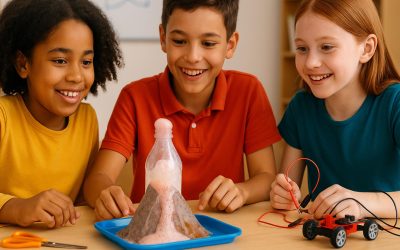In a world that can often feel fast-paced and overwhelming, teaching children mindfulness and emotional intelligence is more important than ever. Mindfulness is the practice of paying attention to the present moment without judgment, and it can help children develop a greater understanding of their emotions and the emotions of others. This article will explore the importance of mindfulness for children and provide practical tips for helping them cultivate emotional resilience and kindness.
The Power of Mindfulness for Children
Mindfulness can help children in many ways. It can improve their focus and attention, reduce stress and anxiety, and help them regulate their emotions. By learning to be more present and aware, children can develop a greater sense of calm and well-being. As one article from Mindful.org explains, “teaching children to be with their emotions, rather than being swept up by them, is a gift for a lifetime” [1].
Nurturing Emotional Resilience
One of the greatest benefits of mindfulness is that it can help children develop emotional resilience. This means they are better able to cope with challenges and setbacks. Mindful.org offers a five-step process for nurturing emotional resilience in children:
- Check in with yourself: Parents need to be able to manage their own emotions to support their children.
- Be there for yourself: Accept that children will experience difficulties and support yourself through it.
- Help them to name it: Identify and name feelings (sad, confused, angry, scared) to help children understand them.
- Use the “And”: Acknowledge their feelings and offer support (e.g., “I know this is hard, and I am here for you.”). Avoid fixing or advising immediately.
- Help them find calm: Teach strategies to calm their nervous system, such as mindful breathing practices [1].
Mindful Breathing for Kids
Mindful breathing is a simple yet powerful tool that can help children calm their minds and bodies. Here are a few kid-friendly breathing exercises from Mindful.org:
- Belly Breathing: Place a hand on your belly and feel it rise and fall with each breath.
- Mindful Breathing: Simply notice the breath as it moves in and out of the body.
- Teddy Bear Breath: Lie down with a stuffed animal on your belly and watch it move up and down as you breathe.
- Four Square Breathing: Breathe in for a count of four, hold for four, breathe out for four, and hold for four [1].
Cultivating Kindness
Mindfulness and kindness go hand in hand. When children are more aware of their own emotions, they are better able to understand and empathize with the emotions of others. Encouraging acts of kindness, both big and small, can help children develop a sense of compassion and connection to others.
Q&A
Q1: How can I introduce mindfulness to my child in a fun way?
A1: You can introduce mindfulness through games and activities. For example, you can go on a “listening walk” where you pay attention to all the sounds you can hear, or you can do a “mindful eating” exercise where you slowly savor a piece of fruit.
Q2: What are some simple ways to practice kindness as a family?
A2: You can create a “kindness jar” where you write down acts of kindness you see or do. You can also volunteer together as a family or simply make an effort to say kind words to each other every day.
Q3: How can mindfulness help my child with school?
A3: Mindfulness can help children improve their focus and concentration in the classroom. It can also help them manage stress and anxiety related to schoolwork and exams.
Sources
- [1] O’Leary, W. (2020, March 18). Helping Children Embrace Big Emotions. Mindful. Retrieved from https://www.mindful.org/helping-children-embrace-big-emotions/








0 Comments